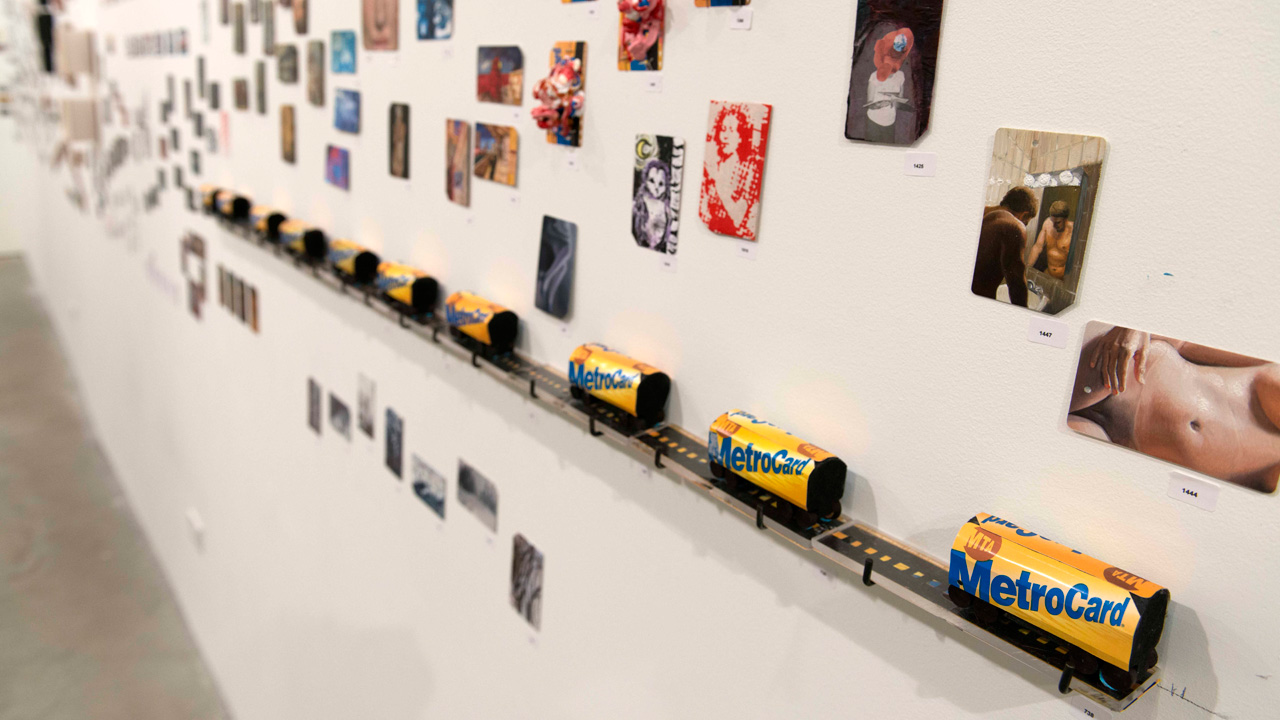Over 800 artists from from places as far as South Korea and New Zealand, age five to 70-something, some renowned, other less so, submitted 2,400 MetroCard-based works to “Single Fare 3.”
“With the exception of a couple of pieces that showed up totally damaged, every single thing we got was hung,” exhibit organizer Jean-Pierre Roy tells ANIMAL before last night’s jam-packed opening.

In three years, the wildly popular show moved from a pop-up space in a Brooklyn artists’ studio to a 3500 sq ft TriBeCa gallery and today, it goes digital. For the first time, organizers Michael Kagan and Jean-Pierre Roy collaborated with artist/developer Gordon Austin to build a historical archive and online sales platform for the much-appreciated egalitarian art happening — an organized, meta-tagged “institutional memory.”
“Each year we keep trying to raise the reach of not only the artists invited to participate,” Roy tells ANIMAL, “but the people who get to view it.”
 If artists all over the globe are submitting — and they did — makes sense that they have access to view the work of the whole community of contributors, too.
If artists all over the globe are submitting — and they did — makes sense that they have access to view the work of the whole community of contributors, too.
Just about every style derivative of every artistic movement imaginable is represented — impressionist paintings, hyperrealist drawings, graphic designs, combines, kinetic sculpture, interactive work, as well as a handful of craftsy street-fair-type “buckeye” pieces.
Last time at Single Fare 2, one artist pushing the limits submitted a wall-mounted video piece built off of an iPod Nano. No video work this year, but one of the MetroCards did show up deep-fired.
The pieces are scattered across the space in a salon style installation. Because of the sheer volume, the work was hung as it was entered, grouped improvisationally with an eye on the way it opened up rivers of negative space. “It’s like jazz,” Roy says, “It’s a subtle balance of wanting to author the wall without being fussy.”

ANIMAL favorites include Micah Ganske’s 3D-printed series of 3D MetroCards, Jeffrey Gipe’s stop-and-frisk piece of course, and a very impressive interactive model of a peep show appropriating the MetroCard’s pin-hole by Takeshi Miyakawa, whom you might remember as the artist detained last year for his Bedford Avenue lamppost tribute art cops briefly mistook for terrorism.
The egalitarian atmosphere and inclusivity might be one of the biggest draws of the show for fans and artists alike — which makes sense since it’s based around the emblem of the world’s greatest equalizer: the New York City Subway.
All work is numbered, but not named. Artists who have gallery shows in New York and LA and have sold paintings for six figures are peppered among the rest. Each MetroCard is priced exactly the same at $100, 70% of which goes to the artist.
“People are excited, they begin to line up outside expecting to pay thousands for some of the more high-profile artists,” Kagan says, “It’s a chance for their fans and students to start collecting.”
The one common constraint, that the work has to incorporate a MetroCard, has allowed many of the artists to try things they don’t normally do. Jenny Walton and Samuel Evanson are among the dozen or so artists that in the past have landed solo exhibitions as a result.
Artists that usually work with singular pieces tried their hand at series and sequencing. Others that work on larger, mural-sized formats, “meaty loaded-brush abstract painters,” for instance, had to reconsider their gestures and way of image management for the tiny canvas of the MetroCard.

The level playing field has also fostered a healthy sense of competition. For the first shows, some of the high profile artists may have submitted work that wasn’t quite up to their usual level of quality, and Kagan says, “artists we never heard of blew them out of the water.” Those have since resubmitted with more ambitious pieces.
“You don’t get much for making these MetroCards, but you do get to be part of this community which is more fun, more exhilarating than some of the more hermetic exhibition experiences of a really serious solo show,” Roy says. “It’s become athletic in a way.”
“The online thing allows people to not just keep excited, but stay in touch with the history of ‘Single Fare’ between shows,” he adds. One of the original issues was that people were really excited about the idea, but didn’t know what the possibilities of the medium were. The digital archive changes that.
“Each year,” Roy says, “from here on down the work is going to be crazier and more ambitious.”
(Photos: Eugene Reznik/ANIMAL New York)



